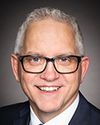Thank you.
I would like to start by acknowledging that although we may not be together in the same place for this meeting, we are all on Turtle Island. Indigenous peoples have been on this land since the first sunrise.
I want to take a moment to acknowledge our elders, who are the keepers of our knowledge and culture and who are at increased risk during this health pandemic. I want to acknowledge all the people who are working hard on the front lines and behind the scenes to keep indigenous nations and Canada safe from COVID-19.
I would like to acknowledge the leaders and community members on the ground who are putting themselves at risk to ensure operations are maintained and families are taken care of. Whether it is running errands for others, delivering supplies such as groceries, water or medicine, or standing for hours at the road checks to help flatten the curve, I want to say chi-meegwetch, thank you from the bottom of my heart for doing that work and being the backbone of this country right now.
I thank the committee for the work you are doing and for inviting me to speak today about Canada’s response to the COVID-19 pandemic. I will speak about how the pandemic is impacting indigenous Anishinabe and Dakota people in what is now southern Manitoba.
I hope that this meeting will be fruitful and further inform the way forward. In my presentation I am going to focus on four key determinants of first nations health, how they are impacted by the COVID-19 pandemic and what is needed to effectively support our communities. At the heart of the determinants of health are inequities in the health system, inequities with federal funding, and ongoing inequities the communities are facing that make our elders and our youth so vulnerable.
I begin by focusing on health inequities that first nations people face in Canada. When it comes to accessing health care services and professionals, indigenous peoples are the most marginalized in the country, with the poorest health outcomes. As just one example, a joint study released last year by the First Nations Health and Social Secretariat of Manitoba and the Manitoba Centre for Health Policy demonstrated that decades of poor health outcomes have resulted in a gap in life expectancy between status first nations and all other Manitobans that now sits at 11 years. Shockingly, this 11-year gap is growing.
This lack of access to health care was allowed to develop over decades and many administrations. First nations reserves are often remote and far from major cities in which there is better access to health care. It is important to remember that displacement of Anishinabe and Dakota nations made way for those cities, such as Winnipeg and Brandon, with large health hubs and resources. I am concerned about our fly-in communities such as Poplar River, Pauingassi and Little Grand Rapids, which are particularly vulnerable in this pandemic. When the rest of the country comes to a halt or adjusts its production, transportation and distribution schedules, the impact hits our remote communities hard. They rely on supplies and health professionals from outside of their communities. For first nations living off reserve, we need only think of the death of Brian Sinclair to know that racism and stereotypes can be deadly in our cities as well.
As we continually check in with our communities, we hear their concerns. I can tell you that as of yesterday, Little Grand Rapids is experiencing a shortage of liquid baby formula at their Northern store. We ask that the systemic inequalities be addressed once and for all, with increased access to health care on reserve, with special consideration for remote communities.
Sadly, the inequities continue with the response to COVID-19. While we applaud the initial steps of this government with the indigenous community support fund, and are encouraged by the aid announced over the weekend for indigenous businesses suffering COVID-19 losses, there is a monumental financial shortfall that will cause hardship. This past Friday, CBC’s Power & Politics host Rosemary Barton estimated that an unprecedented $113 billion has been allocated to help Canada thus far with the pandemic. Only $621 million is earmarked for indigenous communities. The 2016 Canadian census reported that indigenous people account for 4.9% of the national population, yet indigenous people are receiving just over half of 1% of the relief funds allocated by Ottawa. This is clearly disproportionate, and first nations are still left to manage in poverty.
While the argument may be that first nations are eligible for some of the billions in aid available to regular Canadians, for example, the increase in GST rebates or child tax credit, that will not be close to the extent that would close the gap between $621 million and the $113 billion. We ask that the funding for the indigenous community support fund be increased to equitably reflect the first nations population and realities, realities created by many consecutive Canadian governments. We ask that any proposal processes move quickly to the approval stage due to the state of emergency we find ourselves in.
Another area of concern is off-reserve members of our communities. Approximately half of first nations populations now live off reserve and in urban centres, yet we are not funded to care of our off-reserve members.
Chiefs are receiving calls every single day asking for help. With just $15 million of the indigenous community support fund allocated for urban indigenous peoples and divided among first nations, Inuit and Métis organizations across the country, it is simply not enough.
We ask that the funding for off-reserve services be increased to appropriately reflect population dynamics in urban centres.
I will now take a moment to highlight other inequalities that impact first nations, specifically food security and infrastructure deficits.
When it comes to food security, indigenous peoples have been in precarious and vulnerable situations since the disruption of our agricultural and hunting economies. Because so many of our families are already experiencing food scarcity, this crisis has made this situation so much worse.
We rely on strong partnerships, like the one with the Breakfast Club of Canada. Our 34 communities applied to the COVID-19 emergency fund, with a low barrier application and fast response. A big meegwetch to the Breakfast Club of Canada for their strong support.
As first nations, we have always hunted, fished and trapped to survive and feed our families. In this time of crisis, with restricted movement to the surrounding cities and municipalities, we are trying to return to traditional food sources and harvesting to increase our food security.
We ask for financial help to support the implementing of community food security projects.
The COVID-19 pandemic has reinforced that there is a lack of housing and a poor quality of existing infrastructure on reserve.
Where do you isolate in a community when there are chronic housing shortages and more than a dozen people in one home? There is a lack of on-reserve facilities and resources for community members struggling with addictions.
While we applaud the $50-million allocation for women's shelters and sexual assault centres, which includes up to $10 million for facilities on reserve and in indigenous communities, more is needed. There are only 46 shelters funded by Indigenous Services Canada across the entire country.
We ask for more investment in first nations' infrastructure for housing facilities and shelters.
Lastly, I would like to speak about the well-being of our elders and our youth.
From conversations with our chiefs and members, we know that many are concerned about the safety of our elders from the virus that disproportionately kills older people.
Elders are sacred in our communities. Not only are they much loved members of our families, but they carry our culture and knowledge, languages, our histories and traditions.
If the disease hits our communities and the personal care homes like it has in other provinces, it would deal a heavy blow to the intergenerational knowledge systems of our people. We need our elders close and cared for. We need more homes on reserves because our elders are not always treated well in personal care homes off reserve. We have just two personal care homes for elders in all of our 34 communities.
I want to acknowledge and thank the hard work and dedication of the Manitoba first nations personal care home network, our leaders of the on-reserve care homes in Manitoba.
Our communities are also worried about our youth, especially those in post-secondary education. The economic fallout poses a real risk, with no summer job prospects this year and no child care to support single parents. Attending post-secondary programs this fall may not be possible.
Indigenous youth have some of the highest rates of suicide and self-harm in the country, and are overrepresented in the child welfare system. Mental health supports and resources to keep youth engaged during this time of isolation are critical.
We ask for a measurable increase in mental health supports and a new commitment to address addictions on reserve.
We ask for an investment of four additional personal care homes that can serve Anishinabe and Dakota elders in our communities.
I have spoken of the current health inequalities and of the inequitable response to COVID-19. I have spoken of the food security and infrastructure challenges exacerbated by the pandemic.
As I conclude, I want to leave you with a new vision of health transformation.
First nations do not want to inherit a broken health system, but to create a wellness model with our governance and our values, a new and groundbreaking health system for all southern first nations communities that will begin to close the gaps.
We are days away from signing a memorandum of understanding with Canada to make this happen. I should not die a decade before you because I am an Anishinabe man, and my son should not die a decade before your child because he is an Anishinabe.
Let's work towards the Truth and Reconciliation Commission of Canada's call to action 19 and identify and close the gaps in health care outcomes. Reconciliation can mean letting go of the structures and the faulty dynamics that have plagued our relationship for generations.
Statistics and reports document the legacy of systemic neglect and negligence in the health care system for first nations, but together we can build a new future founded on true partnership as the treaties intended.
Chi-meegwetch.



